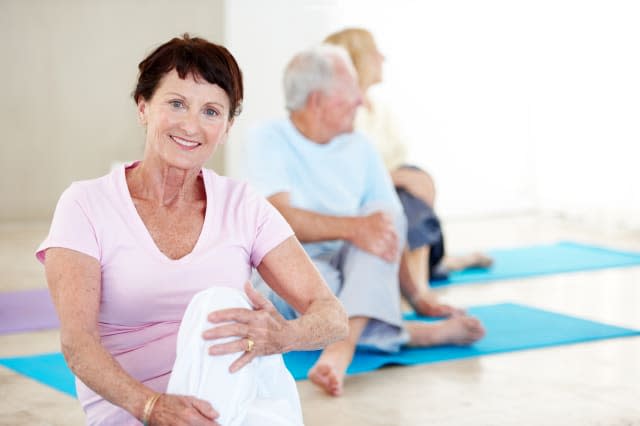Five best exercises for women in their 50s

You're never too old to improve your fitness levels. Once you reach 50, it's even more important to exercise to lower your risk of cancer, stroke, heart disease, and osteoporosis. If you're a woman in your 50s plus, here are five of the best ways to keep fit.
See also: This simple sitting test could predict how long you will live
See also: An hour's walk can cancel out eight hours behind a desk, scientists say
1. Weight training
Once women turn 30 they lose up to 5% of their lean muscle tissue every 10 years —and that number increases after the age of 65. The more muscle you have, the faster your metabolism works and the easier it will be to lose weight and keep it off.
There's no need to worry that lifting weights will make them look big and bulky. Women don't produce as much testosterone to grow as big as men – so matter how heavy the weight you lift, you're never going to get "big."
While you can do weight training at home – with hand weights and a strength training DVD – it's a good idea to get professional guidance in the gym or from a personal trainer when you're starting out. A fitness professional will be able to check your technique and make sure you have the correct posture. They can also show you the best way to lift ways while sitting on a fitness ball, which is a great way to develop your core strength at the same time.
Walking
Once women hit 40, their bone density naturally declines, increasing the risk of osteoporosis, a condition that weakens the bones and makes them more fragile and prone to breaks. According to the NHS, one-in-two women over the age of 50 will break a bone in the UK, and the most common cause is osteoporosis.
Weight-bearing exercise - such as brisk walking, jogging, or racquet sports – is a good way to strengthen the bones and reduce the risk of injury.
Walking is one of the best exercises you can do. Researchers at Brigham and Women's Hospital, USA, found that women who walked for 30 minutes every day were 40% less likely to suffer a hip fracture.
Not only that, research shows that people who walk regularly have a lower risk of cancer, diabetes, stroke and dementia. Walking – particularly in nature - can also help to improve your mood, helping to reduce anxiety and improve feelings of wellbeing.
Dancing
Whether you go opt for swing, Zumba or ceroc, moving to the music is a great way to get fit.
Dancing is a great weight-bearing, aerobic exercise that will help to keep your heart and lungs healthy while toning your muscles.
If you want to burn calories, opt for a fast-paced salsa style rather than ballroom. An hour of Zumba dancing (invest in a Zumba fitness DVD or find a class near you) can burn 250 calories in just 30 minutes.
Exercising to music has been shown to boost your performance and improve your mood. A study published in Circulation: Heart Failure found that people with cardiac conditions who danced for just 20 minutes three times a week saw their heart health improve significantly more than those who stuck to traditional cardio workouts. So turn up the volume!
Swimming
If weight bearing exercises like walking and dancing are too much for your joints, consider cycling or swimming. Low-impact exercises are a good choice for anyone with a knee or joint problem.
If you don't feel confident on the road, an exercise bike can be a good way to get your heart going and burn calories. Cycling during your favourite TV show can help ensure you stick to a routine.
Swimming is another great choice for any one with joint problems as the water supports your weight. If you push yourself hard, you'll burn calories and give your heart and lungs a good workout. Swimming is believed to improve the posture and works more than two-thirds of the body's muscles, exercising your legs, stomach and arms.
Yoga
We lose flexibility as we get older, and yoga is a great way to stay supple and avoid a lot of the discomfort often experienced in middle age. As well as exercising your muscles and improving your posture and balance, yoga has been shown to help lower blood pressure and reduce stress and anxiety.
If you have problems getting a good night's sleep, yoga may help with that too. A 2004 study conducted by Harvard researchers found that an eight-week programme of yoga significantly improved sleep quality for those suffering from insomnia.
Meanwhile, a 2005 German study found that women who described themselves as 'emotionally distressed' experienced significant improvements in their mental wellbeing after taking two 90-minute yoga classes a week for three months. At the end of the study, the women's depression scores had improved by 5%, anxiety by 30% and overall wellbeing by 65%.
Find a local class, or do a yoga DVD at home.



